Do you have a question about the Toyota Camry 2004 and is the answer not in the manual?
Provides an overview of the vehicle's instruments and controls.
Details the instrument cluster for the 2AZ-FE engine.
Details the instrument cluster for 1MZ-FE and 3MZ-FE engines.
Covers operation and features related to keys and doors.
Explains how to lock and unlock doors using the key.
Details the function and use of rear door child protectors.
Instructions on how to change the automatic door locking modes.
Explains how to lock and unlock doors using the wireless remote.
Instructions on operating the driver's side window.
Describes the jam protection function for power windows.
Details the luggage security system for the trunk.
Instructions on how to open and secure the vehicle's hood.
Explains how the theft deterrent system activates and operates.
Procedures for stopping the theft deterrent system alarm.
Methods to cancel the theft deterrent system.
Steps to test the functionality of the theft deterrent system.
Instructions for operating the moon roof in sliding mode.
Instructions for operating the moon roof in tilting mode.
Covers various occupant restraint systems in the vehicle.
Information and adjustments related to vehicle seats.
Details on the proper use and function of seat belts.
Information regarding the Supplemental Restraint System (airbags).
Guidelines and precautions for child restraint systems.
Specific information related to the front seats.
Safety precautions and advice for front seat occupants.
Details regarding front seats equipped with side airbags.
Safety precautions for adjusting vehicle seats.
General information about the vehicle's seat belt system.
Essential safety precautions for using seat belts.
Instructions on how to install the seat belt comfort guide.
Details on the driver and front passenger airbag systems.
Essential precautions for using child restraint systems.
Instructions for installing an infant seat using a seat belt.
Location and use of anchor brackets for child restraint top straps.
Step to remove the head restraint for anchor bracket access.
Instructions for Type A child restraint system installation.
Instructions for Type B child restraint system installation.
Details on steering wheel and mirror adjustments and features.
Information on adjusting power pedals in vehicles with automatic transmission.
Guidance on adjusting outside rear view mirrors for optimal visibility.
Explanation of the anti- glare function of the inside rear view mirror.
Covers operation of lights, wipers, and defogger systems.
Details on the automatic shut-off feature for headlights.
Explanation of the Daytime Running Light system.
Explanation of the Daytime Running Light system's operation.
Instructions for operating the front fog lights.
Details on the illuminated entry system for interior lights.
Explanation of the ignition switch light's function.
Operation of windshield wipers and washer system.
Explains various gauges, meters, and reminder indicators.
Details on the engine coolant temperature gauge.
Information on the odometer and trip meters.
Explains the driver's seat belt reminder light and buzzer.
Details the front passenger seat belt reminder light.
Information on the malfunction indicator lamp and its causes.
Warns when the fuel level is low.
Explains the ABS warning light and its implications.
Indicates when doors are not fully closed.
Explains the SRS airbag system warning light.
Warns of issues with the Vehicle Stability Control system.
Reminds when to change the engine oil.
Alerts the driver to remove the key.
Covers ignition switch, transmission, and parking brake operations.
Details the function and display of the selector lever.
Guidance for normal driving with the automatic transmission.
Instructions for backing up the vehicle safely.
Tips for good driving practices with the transmission.
Troubleshooting for shifting out of Park.
Details the selector lever for 1MZ-FE and 3MZ-FE engines.
Guidance for normal driving with automatic transmission.
Instructions for backing up the vehicle safely.
Tips for good driving practices with transmission.
Troubleshooting for shifting out of Park.
Recommended speeds for shifting gears in manual transmission.
Maximum speeds allowed for each gear.
Instructions for normal operation of the traction control system.
Explains the VSC warning light for stability control issues.
Steps to activate the cruise control system.
How to set the desired speed for cruise control.
How to reset cruise control to a faster speed.
How to reset cruise control to a slower speed.
How to resume the previously set cruise control speed.
What to do if the cruise control indicator light flashes.
Information about the vehicle's car audio system.
Basic information and overview of the audio system.
Details about the vehicle's radio antenna.
Information on using the cassette player.
Instructions for using the Type 1 compact disc player.
Details specific controls and features of the Type 1 audio system.
Explains the program function for the cassette player.
Information on operating the compact disc player.
Details on the FM1·2 radio function.
How to adjust tone and balance settings.
How to switch to compact disc player operation.
How to scan tracks on a specific compact disc.
How to scan first tracks of all discs in the magazine.
Radio seek function for finding stations.
Information on skipping tracks on a cassette.
How the TA volume memory function works.
How to tune radio stations manually.
How to select program types from RDS stations.
Information about common radio reception problems.
Precautions for using labeled discs.
Precautions for using low quality discs.
Covers the operation of the air conditioning system.
How to adjust the temperature settings.
How to select air flow modes for the vents.
How to turn the air conditioning on and off.
Tips for using the air conditioning system effectively.
Recommended settings for air conditioning operation.
Recommended settings for ventilation mode.
Settings for defogging the inside of the windshield.
Settings for defrosting the outside of the windshield.
How to adjust temperature settings in automatic mode.
How to adjust fan speed in automatic mode.
How to select the air source for the AC system.
Tips for using the air conditioning system effectively.
Recommended settings for air conditioning operation.
Recommended settings for ventilation mode.
Settings for defogging and defrosting windshields.
Information on various other vehicle equipment.
Details on the outside temperature display.
How to cycle through information on the multi-information display.
Information on average fuel consumption calculation.
How the driving range is calculated and displayed.
Information on the elapsed driving time display.
Details on the vehicle's compass system.
Instructions for calibrating the compass for accuracy.
Warning about adjusting the compass display while driving.
How to use the cigarette lighter.
How to use and remove the front and rear ashtrays.
Steps for programming the HomeLink system for garage door openers.
Programming HomeLink for gates and Canadian market devices.
How to program HomeLink for other devices like security systems.
How to reprogram a single HomeLink button.
Instructions for operating the HomeLink system.
Information about auxiliary storage boxes.
Details about the overhead console box.
How to access the upper tray of the console box.
How to access the rear console box.
How to use the rear cup holder.
How to use grocery bag hooks and precautions.
Instructions for raising and lowering the rear sun shade.
Information on using the correct size floor mats and locking clips.
Provides detailed specifications for the vehicle.
Recommendations for the vehicle's break- in period.
Information on fuel type, octane rating, and tank capacity.
Information on cleaner burning gasoline and oxygenates.
Warnings about gasoline containing MMT additive.
Advice on gasoline quality and driveability issues.
Advice for driving Toyota vehicles in foreign countries.
Highlights the importance of regularly checking engine oil level.
Information on the vehicle's brake system.
Explains the function of the brake booster.
Guidance on effectively using the ABS brake pedal.
Explains the ABS warning light for vehicles without VSC.
Details on the drum- in- disc type parking brake system.
Explains the Brake Assist system for vehicles with VSC.
Information on the vehicle identification number (VIN).
Precautions regarding modifications to the suspension and chassis.
Details on tire size markings and interpretation.
Information on DOT and Tire Identification Numbers.
Explanation of uniform tire quality grading system.
How to find tread wear indicators on tires.
Information about tire ply composition and materials.
How to distinguish radial from bias- ply tires.
Identifies and describes each section of a tire.
Explanation of the treadwear grade for tires.
Explanation of tire traction grades.
Definition of cold tire inflation pressure.
Definition of maximum tire inflation pressure.
Definition of recommended tire inflation pressure.
Definition of accessory weight for vehicles.
Definition of curb weight for vehicles.
Definition of maximum loaded vehicle weight.
Definition of normal occupant weight.
Definition of weather side of a tire.
Table showing occupant loading and distribution by seating capacity.
Information on the total load capacity of the vehicle.
Information on the vehicle's towing capacity.
Information on how cargo capacity is determined.
Warning about exceeding load limits.
Guidelines for stowing cargo and luggage safely.
Steps to determine the correct load limit for the vehicle.
Information on summer tires and their limitations.
Information on all-season tires and their performance.
Warning about mixing tire types.
Covers starting the engine and general driving advice.
Step-by-step instructions on how to start the engine.
Checks to perform before cranking the engine.
Normal procedure for starting the engine.
Advice on driving through water and its effect on brakes.
Safety precautions before driving off and while driving.
Instructions for dinghy towing with manual transmission.
Warning about potential damage from dinghy towing.
General advice and precautions for towing trailers.
Advice to consult Toyota dealer for towing kit information.
Warning about exceeding vehicle and trailer weight limits.
Information on trailer hitch weight capacities.
Understanding Gross Vehicle Weight Rating (GVWR).
Advice on using axle- mounted hitches and hitch placement.
Requirements for trailer brakes and safety chains.
Compliance requirements for trailer lights.
Recommendations for trailer towing break-in period.
Information on increased maintenance frequency when towing.
Essential tips for safe trailer towing.
Procedures for handling various vehicle emergencies.
Basic checks to perform when the vehicle will not start.
Procedure for starting a flooded engine.
Step-by-step guide for jump starting a vehicle.
Information about the booster battery used for jump starting.
Shows where to connect jumper cables for 2AZ-FE engine.
Shows where to connect jumper cables for 1MZ-FE/3MZ-FE engines.
Troubleshooting steps when engine speed cannot be increased.
Safety precautions to follow when jacking the vehicle.
Steps for safely pulling over with a flat tire.
Actions to take after stopping with a flat tire.
Securing the vehicle after stopping for a flat tire.
Ensuring passenger safety when changing a tire.
Emphasizes reading tire change instructions.
Information and limitations of the compact spare tire.
Warnings about using the compact spare tire.
Lists tools and spare tire needed for tire change.
Importance of knowing tool usage and storage for emergencies.
Instructions for properly storing the jack.
Safety reason for properly storing the jack.
Steps to remove the spare tire from its location.
How to block the wheel to prevent vehicle rolling while jacking.
Instructions for removing wheel ornaments from steel wheels.
How to loosen wheel nuts before raising the vehicle.
How to correctly position the jack for lifting the vehicle.
Instructions for safely raising the vehicle with a jack.
Steps involved in changing a vehicle wheel.
How to reinstall wheel nuts finger tight.
How to lower the vehicle and tighten wheel nuts.
Instructions for reinstalling wheel ornaments on steel wheels.
Instructions for securely storing tools, jack, and flat tire.
Safety warning about securing items to prevent injury.
Guidance for situations when the vehicle needs to be towed.
Instructions for towing with a wheel lift type truck.
Towing information when the vehicle is lifted from the front.
Towing information when the vehicle is lifted from the rear.
Instructions for towing using a flat bed truck.
Warnings and advice for towing with a wheel lift truck.
Towing instructions for lifting the front of the vehicle.
Towing instructions for lifting the rear of the vehicle.
Warning about towing automatic transmission vehicles from the rear.
Warnings and advice for towing with a flat bed truck.
Instructions and warnings for towing with a sling type truck.
Warning about potential body damage from sling type towing.
Location of towing eyelets on the front of the vehicle.
Location of towing eyelets on the rear of the vehicle.
Instructions on how to install the front towing eyelet.
Installing towing eyelet with a compact spare tire.
Installing towing eyelet without a compact spare tire.
Critical warning about securely installing the towing eyelet.
Step to remove the front towing eyelet cover.
How to secure the front towing eyelet to the bumper.
First step to shift lock override: turn ignition key to LOCK.
Step to access the shift lock override button.
How to use the shift lock override button to shift out of Park.
Shifting the selector lever to neutral using the override.
Replacing the cover after using shift lock override.
Starting the engine after using shift lock override.
Recommendation to have the system checked after using override.
Steps to take if the wireless remote control transmitter is lost.
Information on preventing corrosion and maintaining appearance.
Common factors contributing to vehicle corrosion.
Environmental conditions that accelerate corrosion.
Guidelines for preventing corrosion on the vehicle.
How interior moisture can cause corrosion.
Benefits of using mud shields for corrosion protection.
Importance of proper garage ventilation for corrosion prevention.
General advice on washing the vehicle.
The importance of regular vehicle washing.
Instructions for hand-washing the vehicle.
Safety caution for cleaning under the vehicle.
How to clean plastic bumpers carefully.
Method for removing road tar from paint.
Warning about using organic substances for cleaning.
Advice on using automatic car washes.
Recommendations for polishing and waxing the vehicle.
Checking windshield washer nozzles during waxing.
Warning about blocked windshield washer nozzles.
Precautions for vehicles with side and curtain shield airbags.
Warning about liquid on the floor affecting airbags.
Warning about water on the floor affecting electronics and causing corrosion.
How to clean vinyl upholstery.
Warning about using solvents on interior surfaces.
How to clean vehicle carpets using foam shampoo.
Advice on cleaning carpets and seat belts.
How to clean vehicle windows.
Warning about scratching rear window heater wires.
How to clean leather upholstery safely.
Warnings about cleaning leather upholstery and avoiding stains.
Covers DIY maintenance procedures for the vehicle.
Maintenance procedures related to the engine and chassis.
Checking the radiator and condenser for dirt and blockages.
How to check the power steering fluid level.
Steps for inspecting and adjusting tire inflation pressure.
Consequences of improperly inflated tires and related risks.
Effects of low tire pressure on vehicle handling and safety.
Effects of high tire pressure on vehicle handling and safety.
How to check tire tread for wear indicators and damage.
Guidelines for selecting replacement tires.
Warnings about tire replacement and mixing tire types.
Recommendations for using snow tires or chains.
Guidelines for selecting snow tires.
Warnings about using incorrect size snow tires.
Instructions for installing snow tires on all wheels.
Warnings about driving with snow tires.
Guidance on selecting the correct size tire chains.
Instructions for installing tire chains on the front tires.
Warnings about driving with tire chains installed.
Warning about using tire chains on compact spare tires.
When to replace damaged wheels due to bending, cracks, or corrosion.
Guidelines for selecting replacement wheels.
Warning about using incorrect size wheels and mixing tire types.
Precautions for maintaining aluminum wheels.
Covers DIY maintenance procedures for the vehicle.
Maintenance procedures for electrical components.
Safety precautions when working with the vehicle battery.
Safety precautions when working with the vehicle battery.
Emergency procedures for battery acid contact.
Proper disposal methods for used oil and filters.
Important notices regarding battery maintenance.
How to check battery condition using indicator colors.
Precautions to follow when recharging a vehicle battery.
Safety caution for battery recharging.
Notice about recharging the battery while the engine is running.
Troubleshooting electrical issues by checking fuses.
Reference to fuse locations in Section 7-1.
How to remove Type A fuses using the pull-out tool.
Recommendation to keep spare fuses in the vehicle.
Warning about using incorrect fuse amperage.
Instructions for adding washer fluid to the reservoir.
Caution about using engine antifreeze as washer fluid.
Instructions for replacing vehicle light bulbs.
Safety precautions when replacing hot or pressurized bulbs.
Instruction to use only the listed type of bulb.
Table listing various light bulbs, their numbers, wattage, and types.
Identifies the tail and rear side marker light.
Identifies the rear turn signal light.
Identifies the back-up light.
Identifies the stop/tail light.
Identifies the tail and rear side marker light.
Identifies the rear turn signal light.
Identifies the back-up light.
Identifies the stop/tail light.
Warning about replacing front fog or license plate bulbs.
Provides detailed specifications for the vehicle.
Specifications related to the vehicle's engine.
Details on various service specifications for the vehicle.
Specifications for the vehicle's cooling system.
Specifications for the vehicle's battery.
Specifications for the clutch system.
Specifications for the manual transaxle.
Specifications related to the vehicle's braking system.
Specifications for the vehicle's steering system.
Table of tire sizes and recommended cold inflation pressures.
Specification for wheel nut torque.
Note regarding complete tire information.
List of fuses for Type A, including circuit and amperage.
List of fuses for Type C, including circuit and amperage.
Provides an overview of the vehicle's instruments and controls.
Details the instrument cluster for the 2AZ-FE engine.
Details the instrument cluster for 1MZ-FE and 3MZ-FE engines.
Covers operation and features related to keys and doors.
Explains how to lock and unlock doors using the key.
Details the function and use of rear door child protectors.
Instructions on how to change the automatic door locking modes.
Explains how to lock and unlock doors using the wireless remote.
Instructions on operating the driver's side window.
Describes the jam protection function for power windows.
Details the luggage security system for the trunk.
Instructions on how to open and secure the vehicle's hood.
Explains how the theft deterrent system activates and operates.
Procedures for stopping the theft deterrent system alarm.
Methods to cancel the theft deterrent system.
Steps to test the functionality of the theft deterrent system.
Instructions for operating the moon roof in sliding mode.
Instructions for operating the moon roof in tilting mode.
Covers various occupant restraint systems in the vehicle.
Information and adjustments related to vehicle seats.
Details on the proper use and function of seat belts.
Information regarding the Supplemental Restraint System (airbags).
Guidelines and precautions for child restraint systems.
Specific information related to the front seats.
Safety precautions and advice for front seat occupants.
Details regarding front seats equipped with side airbags.
Safety precautions for adjusting vehicle seats.
General information about the vehicle's seat belt system.
Essential safety precautions for using seat belts.
Instructions on how to install the seat belt comfort guide.
Details on the driver and front passenger airbag systems.
Essential precautions for using child restraint systems.
Instructions for installing an infant seat using a seat belt.
Location and use of anchor brackets for child restraint top straps.
Step to remove the head restraint for anchor bracket access.
Instructions for Type A child restraint system installation.
Instructions for Type B child restraint system installation.
Details on steering wheel and mirror adjustments and features.
Information on adjusting power pedals in vehicles with automatic transmission.
Guidance on adjusting outside rear view mirrors for optimal visibility.
Explanation of the anti- glare function of the inside rear view mirror.
Covers operation of lights, wipers, and defogger systems.
Details on the automatic shut-off feature for headlights.
Explanation of the Daytime Running Light system.
Explanation of the Daytime Running Light system's operation.
Instructions for operating the front fog lights.
Details on the illuminated entry system for interior lights.
Explanation of the ignition switch light's function.
Operation of windshield wipers and washer system.
Explains various gauges, meters, and reminder indicators.
Details on the engine coolant temperature gauge.
Information on the odometer and trip meters.
Explains the driver's seat belt reminder light and buzzer.
Details the front passenger seat belt reminder light.
Information on the malfunction indicator lamp and its causes.
Warns when the fuel level is low.
Explains the ABS warning light and its implications.
Indicates when doors are not fully closed.
Explains the SRS airbag system warning light.
Warns of issues with the Vehicle Stability Control system.
Reminds when to change the engine oil.
Alerts the driver to remove the key.
Covers ignition switch, transmission, and parking brake operations.
Details the function and display of the selector lever.
Guidance for normal driving with the automatic transmission.
Instructions for backing up the vehicle safely.
Tips for good driving practices with the transmission.
Troubleshooting for shifting out of Park.
Details the selector lever for 1MZ-FE and 3MZ-FE engines.
Guidance for normal driving with automatic transmission.
Instructions for backing up the vehicle safely.
Tips for good driving practices with transmission.
Troubleshooting for shifting out of Park.
Recommended speeds for shifting gears in manual transmission.
Maximum speeds allowed for each gear.
Instructions for normal operation of the traction control system.
Explains the VSC warning light for stability control issues.
Steps to activate the cruise control system.
How to set the desired speed for cruise control.
How to reset cruise control to a faster speed.
How to reset cruise control to a slower speed.
How to resume the previously set cruise control speed.
What to do if the cruise control indicator light flashes.
Information about the vehicle's car audio system.
Basic information and overview of the audio system.
Details about the vehicle's radio antenna.
Information on using the cassette player.
Instructions for using the Type 1 compact disc player.
Details specific controls and features of the Type 1 audio system.
Explains the program function for the cassette player.
Information on operating the compact disc player.
Details on the FM1·2 radio function.
How to adjust tone and balance settings.
How to switch to compact disc player operation.
How to scan tracks on a specific compact disc.
How to scan first tracks of all discs in the magazine.
Radio seek function for finding stations.
Information on skipping tracks on a cassette.
How the TA volume memory function works.
How to tune radio stations manually.
How to select program types from RDS stations.
Information about common radio reception problems.
Precautions for using labeled discs.
Precautions for using low quality discs.
Covers the operation of the air conditioning system.
How to adjust the temperature settings.
How to select air flow modes for the vents.
How to turn the air conditioning on and off.
Tips for using the air conditioning system effectively.
Recommended settings for air conditioning operation.
Recommended settings for ventilation mode.
Settings for defogging the inside of the windshield.
Settings for defrosting the outside of the windshield.
How to adjust temperature settings in automatic mode.
How to adjust fan speed in automatic mode.
How to select the air source for the AC system.
Tips for using the air conditioning system effectively.
Recommended settings for air conditioning operation.
Recommended settings for ventilation mode.
Settings for defogging and defrosting windshields.
Information on various other vehicle equipment.
Details on the outside temperature display.
How to cycle through information on the multi-information display.
Information on average fuel consumption calculation.
How the driving range is calculated and displayed.
Information on the elapsed driving time display.
Details on the vehicle's compass system.
Instructions for calibrating the compass for accuracy.
Warning about adjusting the compass display while driving.
How to use the cigarette lighter.
How to use and remove the front and rear ashtrays.
Steps for programming the HomeLink system for garage door openers.
Programming HomeLink for gates and Canadian market devices.
How to program HomeLink for other devices like security systems.
How to reprogram a single HomeLink button.
Instructions for operating the HomeLink system.
Information about auxiliary storage boxes.
Details about the overhead console box.
How to access the upper tray of the console box.
How to access the rear console box.
How to use the rear cup holder.
How to use grocery bag hooks and precautions.
Instructions for raising and lowering the rear sun shade.
Information on using the correct size floor mats and locking clips.
Provides detailed specifications for the vehicle.
Recommendations for the vehicle's break- in period.
Information on fuel type, octane rating, and tank capacity.
Information on cleaner burning gasoline and oxygenates.
Warnings about gasoline containing MMT additive.
Advice on gasoline quality and driveability issues.
Advice for driving Toyota vehicles in foreign countries.
Highlights the importance of regularly checking engine oil level.
Information on the vehicle's brake system.
Explains the function of the brake booster.
Guidance on effectively using the ABS brake pedal.
Explains the ABS warning light for vehicles without VSC.
Details on the drum- in- disc type parking brake system.
Explains the Brake Assist system for vehicles with VSC.
Information on the vehicle identification number (VIN).
Precautions regarding modifications to the suspension and chassis.
Details on tire size markings and interpretation.
Information on DOT and Tire Identification Numbers.
Explanation of uniform tire quality grading system.
How to find tread wear indicators on tires.
Information about tire ply composition and materials.
How to distinguish radial from bias- ply tires.
Identifies and describes each section of a tire.
Explanation of the treadwear grade for tires.
Explanation of tire traction grades.
Definition of cold tire inflation pressure.
Definition of maximum tire inflation pressure.
Definition of recommended tire inflation pressure.
Definition of accessory weight for vehicles.
Definition of curb weight for vehicles.
Definition of maximum loaded vehicle weight.
Definition of normal occupant weight.
Definition of weather side of a tire.
Table showing occupant loading and distribution by seating capacity.
Information on the total load capacity of the vehicle.
Information on the vehicle's towing capacity.
Information on how cargo capacity is determined.
Warning about exceeding load limits.
Guidelines for stowing cargo and luggage safely.
Steps to determine the correct load limit for the vehicle.
Information on summer tires and their limitations.
Information on all-season tires and their performance.
Warning about mixing tire types.
Covers starting the engine and general driving advice.
Step-by-step instructions on how to start the engine.
Checks to perform before cranking the engine.
Normal procedure for starting the engine.
Advice on driving through water and its effect on brakes.
Safety precautions before driving off and while driving.
Instructions for dinghy towing with manual transmission.
Warning about potential damage from dinghy towing.
General advice and precautions for towing trailers.
Advice to consult Toyota dealer for towing kit information.
Warning about exceeding vehicle and trailer weight limits.
Information on trailer hitch weight capacities.
Understanding Gross Vehicle Weight Rating (GVWR).
Advice on using axle- mounted hitches and hitch placement.
Requirements for trailer brakes and safety chains.
Compliance requirements for trailer lights.
Recommendations for trailer towing break-in period.
Information on increased maintenance frequency when towing.
Essential tips for safe trailer towing.
Procedures for handling various vehicle emergencies.
Basic checks to perform when the vehicle will not start.
Procedure for starting a flooded engine.
Step-by-step guide for jump starting a vehicle.
Information about the booster battery used for jump starting.
Shows where to connect jumper cables for 2AZ-FE engine.
Shows where to connect jumper cables for 1MZ-FE/3MZ-FE engines.
Troubleshooting steps when engine speed cannot be increased.
Safety precautions to follow when jacking the vehicle.
Steps for safely pulling over with a flat tire.
Actions to take after stopping with a flat tire.
Securing the vehicle after stopping for a flat tire.
Ensuring passenger safety when changing a tire.
Emphasizes reading tire change instructions.
Information and limitations of the compact spare tire.
Warnings about using the compact spare tire.
Lists tools and spare tire needed for tire change.
Importance of knowing tool usage and storage for emergencies.
Instructions for properly storing the jack.
Safety reason for properly storing the jack.
Steps to remove the spare tire from its location.
How to block the wheel to prevent vehicle rolling while jacking.
Instructions for removing wheel ornaments from steel wheels.
How to loosen wheel nuts before raising the vehicle.
How to correctly position the jack for lifting the vehicle.
Instructions for safely raising the vehicle with a jack.
Steps involved in changing a vehicle wheel.
How to reinstall wheel nuts finger tight.
How to lower the vehicle and tighten wheel nuts.
Instructions for reinstalling wheel ornaments on steel wheels.
Instructions for securely storing tools, jack, and flat tire.
Safety warning about securing items to prevent injury.
Guidance for situations when the vehicle needs to be towed.
Instructions for towing with a wheel lift type truck.
Towing information when the vehicle is lifted from the front.
Towing information when the vehicle is lifted from the rear.
Instructions for towing using a flat bed truck.
Warnings and advice for towing with a wheel lift truck.
Towing instructions for lifting the front of the vehicle.
Towing instructions for lifting the rear of the vehicle.
Warning about towing automatic transmission vehicles from the rear.
Warnings and advice for towing with a flat bed truck.
Instructions and warnings for towing with a sling type truck.
Warning about potential body damage from sling type towing.
Location of towing eyelets on the front of the vehicle.
Location of towing eyelets on the rear of the vehicle.
Instructions on how to install the front towing eyelet.
Installing towing eyelet with a compact spare tire.
Installing towing eyelet without a compact spare tire.
Critical warning about securely installing the towing eyelet.
Step to remove the front towing eyelet cover.
How to secure the front towing eyelet to the bumper.
First step to shift lock override: turn ignition key to LOCK.
Step to access the shift lock override button.
How to use the shift lock override button to shift out of Park.
Shifting the selector lever to neutral using the override.
Replacing the cover after using shift lock override.
Starting the engine after using shift lock override.
Recommendation to have the system checked after using override.
Steps to take if the wireless remote control transmitter is lost.
Information on preventing corrosion and maintaining appearance.
Common factors contributing to vehicle corrosion.
Environmental conditions that accelerate corrosion.
Guidelines for preventing corrosion on the vehicle.
How interior moisture can cause corrosion.
Benefits of using mud shields for corrosion protection.
Importance of proper garage ventilation for corrosion prevention.
General advice on washing the vehicle.
The importance of regular vehicle washing.
Instructions for hand-washing the vehicle.
Safety caution for cleaning under the vehicle.
How to clean plastic bumpers carefully.
Method for removing road tar from paint.
Warning about using organic substances for cleaning.
Advice on using automatic car washes.
Recommendations for polishing and waxing the vehicle.
Checking windshield washer nozzles during waxing.
Warning about blocked windshield washer nozzles.
Precautions for vehicles with side and curtain shield airbags.
Warning about liquid on the floor affecting airbags.
Warning about water on the floor affecting electronics and causing corrosion.
How to clean vinyl upholstery.
Warning about using solvents on interior surfaces.
How to clean vehicle carpets using foam shampoo.
Advice on cleaning carpets and seat belts.
How to clean vehicle windows.
Warning about scratching rear window heater wires.
How to clean leather upholstery safely.
Warnings about cleaning leather upholstery and avoiding stains.
Covers DIY maintenance procedures for the vehicle.
Maintenance procedures related to the engine and chassis.
Checking the radiator and condenser for dirt and blockages.
How to check the power steering fluid level.
Steps for inspecting and adjusting tire inflation pressure.
Consequences of improperly inflated tires and related risks.
Effects of low tire pressure on vehicle handling and safety.
Effects of high tire pressure on vehicle handling and safety.
How to check tire tread for wear indicators and damage.
Guidelines for selecting replacement tires.
Warnings about tire replacement and mixing tire types.
Recommendations for using snow tires or chains.
Guidelines for selecting snow tires.
Warnings about using incorrect size snow tires.
Instructions for installing snow tires on all wheels.
Warnings about driving with snow tires.
Guidance on selecting the correct size tire chains.
Instructions for installing tire chains on the front tires.
Warnings about driving with tire chains installed.
Warning about using tire chains on compact spare tires.
When to replace damaged wheels due to bending, cracks, or corrosion.
Guidelines for selecting replacement wheels.
Warning about using incorrect size wheels and mixing tire types.
Precautions for maintaining aluminum wheels.
Covers DIY maintenance procedures for the vehicle.
Maintenance procedures for electrical components.
Safety precautions when working with the vehicle battery.
Safety precautions when working with the vehicle battery.
Emergency procedures for battery acid contact.
Proper disposal methods for used oil and filters.
Important notices regarding battery maintenance.
How to check battery condition using indicator colors.
Precautions to follow when recharging a vehicle battery.
Safety caution for battery recharging.
Notice about recharging the battery while the engine is running.
Troubleshooting electrical issues by checking fuses.
Reference to fuse locations in Section 7-1.
How to remove Type A fuses using the pull-out tool.
Recommendation to keep spare fuses in the vehicle.
Warning about using incorrect fuse amperage.
Instructions for adding washer fluid to the reservoir.
Caution about using engine antifreeze as washer fluid.
Instructions for replacing vehicle light bulbs.
Safety precautions when replacing hot or pressurized bulbs.
Instruction to use only the listed type of bulb.
Table listing various light bulbs, their numbers, wattage, and types.
Identifies the tail and rear side marker light.
Identifies the rear turn signal light.
Identifies the back-up light.
Identifies the stop/tail light.
Identifies the tail and rear side marker light.
Identifies the rear turn signal light.
Identifies the back-up light.
Identifies the stop/tail light.
Warning about replacing front fog or license plate bulbs.
Provides detailed specifications for the vehicle.
Specifications related to the vehicle's engine.
Details on various service specifications for the vehicle.
Specifications for the vehicle's cooling system.
Specifications for the vehicle's battery.
Specifications for the clutch system.
Specifications for the manual transaxle.
Specifications related to the vehicle's braking system.
Specifications for the vehicle's steering system.
Table of tire sizes and recommended cold inflation pressures.
Specification for wheel nut torque.
Note regarding complete tire information.
List of fuses for Type A, including circuit and amperage.
List of fuses for Type C, including circuit and amperage.
| Brand | Toyota |
|---|---|
| Model | Camry 2004 |
| Category | Automobile |
| Language | English |
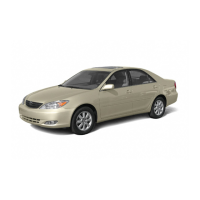

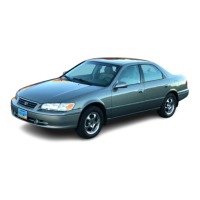
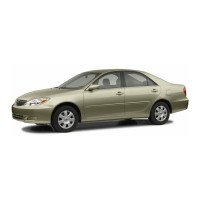
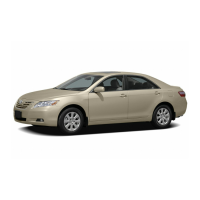
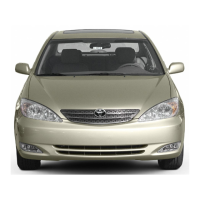
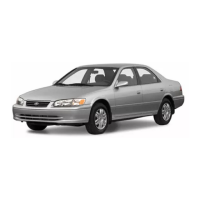
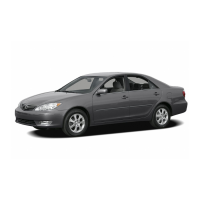
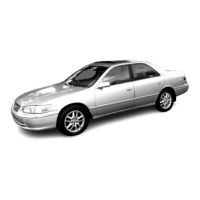
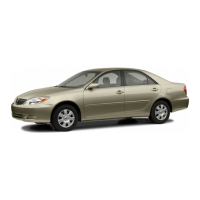

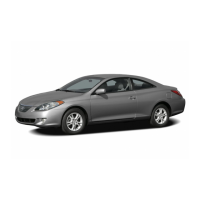
